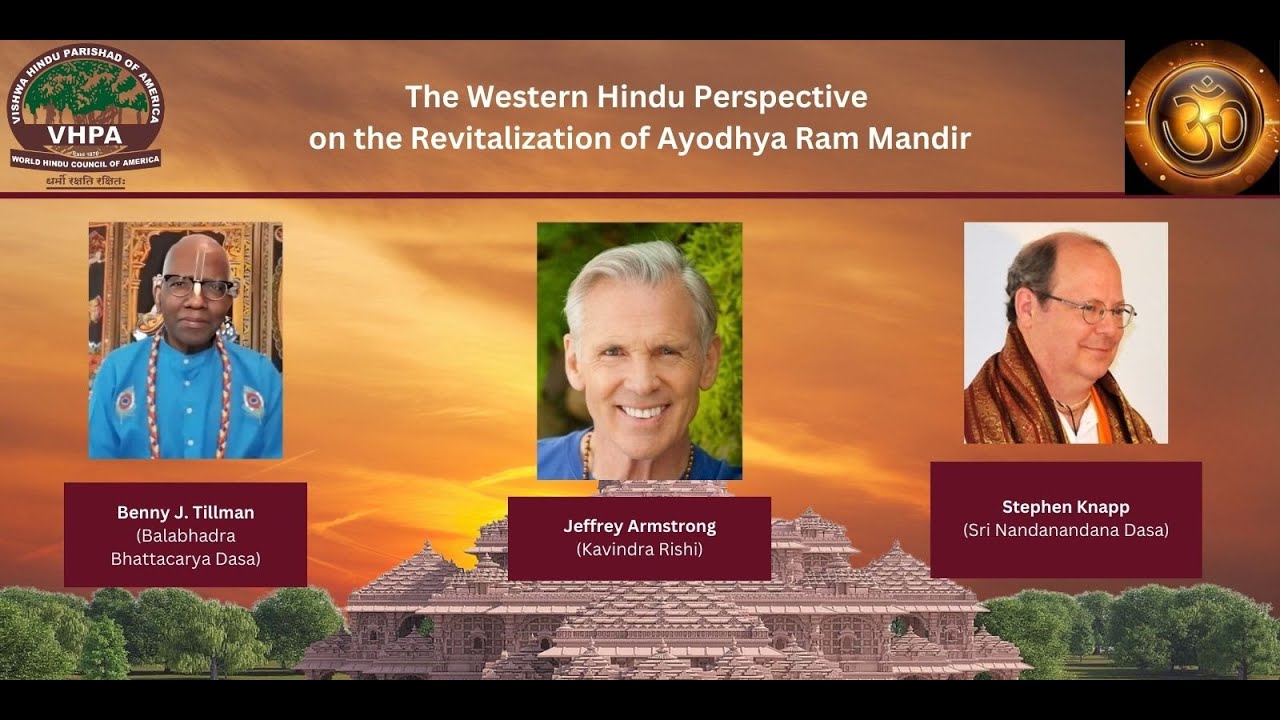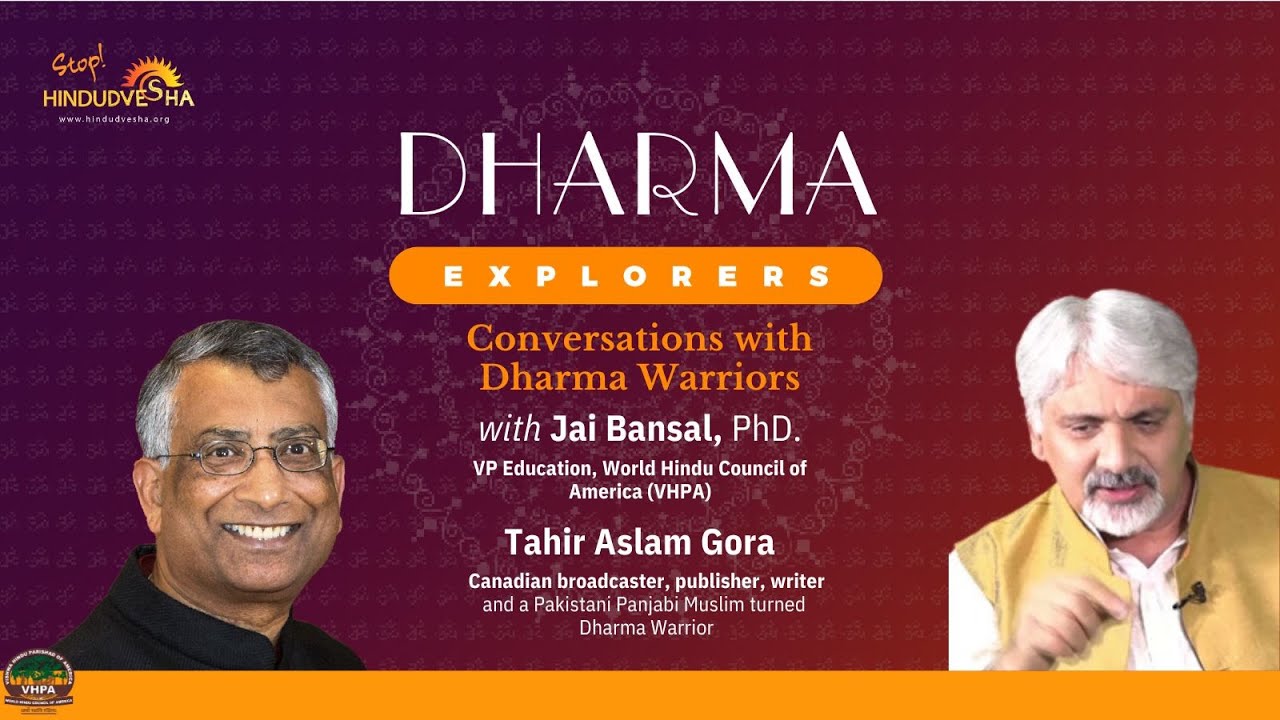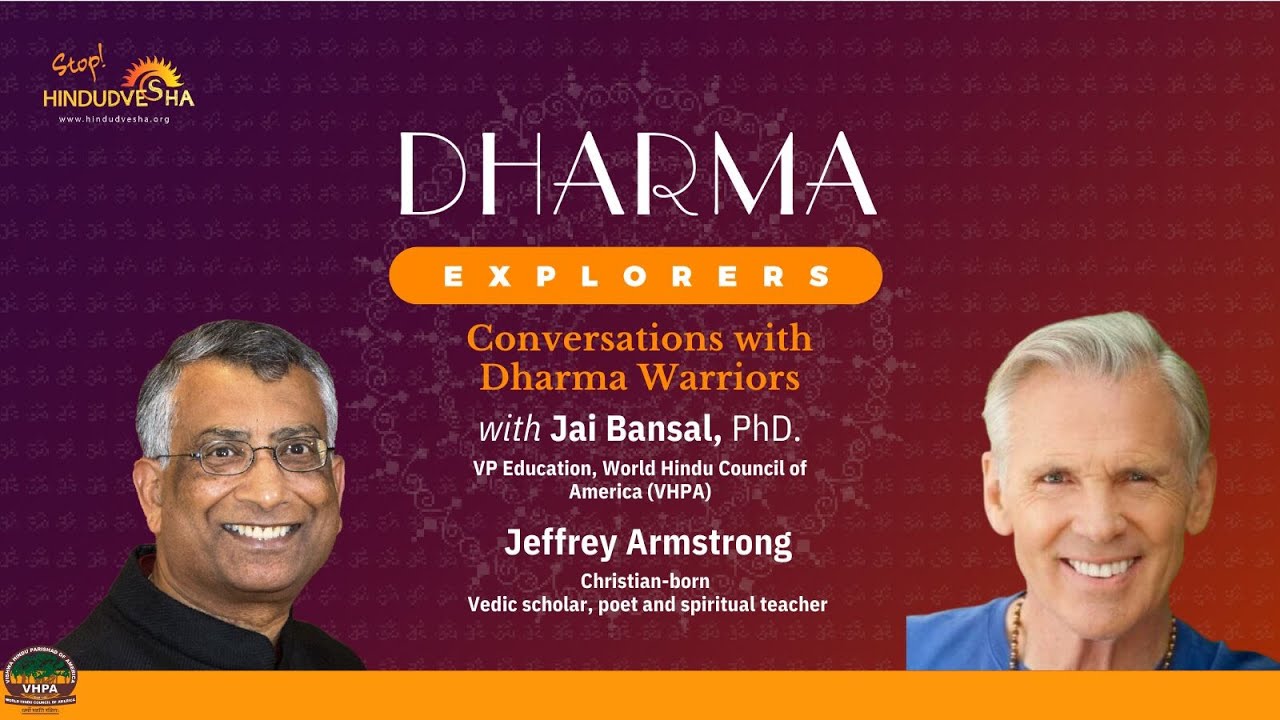

Webinar: The Western Hindu Perspective on the Revitalization of Ayodhya Ram Mandir
Webinar summation by Sh. Nandnandan dasa (Stephen Knapp)
This was a webinar coordinated by Jai Bansal, Ph.D., the Vice President of Education for the World Hindu Council of America (VHPA) with a panel of dedicated western Hindus/Devotees on their views of the new Rama Mandir in Ayodhya. The Panel consisted of Balabhadra dasa (Benny Tillman) President of the Vedic Friends Association and active promoter in Atlanta of Vedic culture; Jeffrey Armstrong (Kavindra Rishi), award winning author of several books and teacher of the Vedic traditions; and Stephen Knapp (Sri Nandanandana dasa), past president of the Vedic Friends Association and author of over 50 books on Vedic spirituality and Indian history, all of whom are also disciples of His Divine Grace Srila A. C. Bhaktivedanta Swami Prabhupada.
The first question from Jai Bansal was how their quest for fulfillment lead them to investigate and then follow the Vedic culture, with each panelist giving their fascinating stories.
From the questions that followed concerning the Ram Mandir:
Jeffrey Armstrong explained that the knowledge of who is the Supreme Being is given by coming in contact with a genuine guru and Vedic Vidya, and the ancient histories of the Itahasas, which includes the Mahabharata and the Ramayana. And one of those avataras of the Supreme is Lord Sri Rama. So, the Rama Mandir is more than the opening of a temple, but is the re-manifestation of an active culture that sees through a world view that is mahatma, meaning it includes everyone, answers everyone’s questions, and treats everyone with respect. The Supreme Being came to this planet as a human being to enlighten humanity, and the Rama Mandir is to honor that Being recognized as Lord Sri Rama.
Jeffrey also gave an explanation on the importance of Sanskrit and its effect on providing an accurate understanding of the Vedic philosophy. Also, the Vedic people never destroyed people, especially to impose its culture or religion on others, but tried to share their knowledge for the benefit of others.
Benny Tillman explained that with most people, who is Lord Ramacandra is not explained fully. The opening of the Rama Mandir is a major event. So, he begs all the followers of Sanatana Dharma to explain that Rama is the Supreme Being. As said in the Bhagavatam (9.10.2): “Being prayed for by the demigods, the Supreme Personality of Godhead, the Absolute Truth Himself, directly appeared with His expansions and expansions of His expansions. Their holy names were Rama, Lakshmana, Bharata and Satrughna. These incarnations thus appeared in four forms as the sons of Maharaja Dasaratha.” Thus, They are all Visnu-tattva.
So, as we open this new temple, lighting the lamp of the glories of Lord Sri Rama, the new temple is so wonderful, but it doesn’t stop there. We need to take the spirit of the temple out to the society. So, it is time that all followers of Vedic Sanatana Dharma to move forward and expand the glory of this amazing culture. And we need to be pro-active in the media to do this.
Stephen Knapp explained things in this way:
The Babri Masjid was built in 1528, named after the Mughal Babur. In the 1980s there was a big push started in India and also in America to erect a Ram temple there. Only in 1985 did the Rajiv Gandhi government allow Hindus access to the site.
So, on one of my usual pilgrimages, I first visited the Babri Masjid in 1990, wanting to see the birthplace of Lord Rama. At that time Ayodhya was very different, with very few guest houses. And the Rama Janmasthan was very secure, with big fences all around topped with barbed wire. There was only one way to enter and you had to leave all of your belongings in the guard shack and then proceed into the Masjid. The Masjid had three domes, however the central dome and the one on the right were both used as a Rama temple, with numerous devotees inside and priests doing puja and worshiping the Sita Rama deities that were there. But the dome on the far left was still used as a mosque, but had little if any activity inside. So, my thought was why do they even keep this site when they could easily make a grand gesture of peace and cooperation to give back to the Hindus and devotees one of the holiest of all sites, the Rama Janmasthan?
But one thing that made it clear to me regarding how politically hot this place of Ayodhya was happened on the train ride going back to Varanasi. I don’t know if this was a sign of what was to come in Godhra, but it was mostly just a lot of pilgrims, Rama bhaktas on the train. But as we were moving out of town, we passed a big playing field where a lot of youth were playing cricket. But then the train started to slow down, and suddenly a man came running down the hall yelling into all the compartments to close the windows. Suddenly, there was the sound of numerous bangs as rocks started hitting the train cars. We closed the windows and ducked for cover. Gradually, the banging of the rocks subsided and the train started to move forward, and I was just prying “Jai Sri Rama, just get me out of here.” That’s when I realized the extra risks that can come from visiting such a place.
In any case, the Babri Masjid was torn down on Dec. 6, 1992, after 464 years of standing. But what was found was a large flat stone with a description in Sanskrit about a large, beautiful temple built in Ayodhya, obviously before the construction of the mosque, dedicated to the person who killed the 10-headed rakshasa, who is obviously Lord Rama. This had fallen from the wall of the masjid proving the masjid had replaced the temple, since parts of the temple were used in constructing the mosque.
I again visited the site about 11 years later in 2001. By then, there was nothing to see at the birth site of Lord Rama. Everything had been cleared up. It was still sectioned off with massive fencing, and you had to leave all your things at the guard shack. But the guards were friendly, surprised to see a westerner there, and got me a guide who took me down the path to the site, which was mostly just a canopy held up by four pillars, under which were priests doing worship to some small and unhoused Sita-Rama deities. So, you barely stopped long enough to do your pranams, say your prayers, and then keep moving. But across the street from the site were buildings with Rama Bhaktas with big pictures on the walls of the Rama temple they wanted to build, which looks quite like what is going up today, but now it is much bigger than what they may have originally had in mind. But it has been a plan that has been brewing for a long time.
Then in 2003, the Archeological Survey of India conducted excavations of the site, ultimately showing evidence of a 10th century North Indian style temple that existed there before the mosque was built. And anyone can see the presentation given by K. K. Muhammed of the various archeological finds that were uncovered that prove the existence of a grand temple at the spot where the Masjid had been erected.
Finally, in November of 2019, India’s supreme court granted permission to Hindu groups to build a Rama Mandir. Then Narendra Modi laid the foundation stone for the temple on Wednesday, August 5, 2020. And now the grand opening of the new Rama temple will be January 22, 2024. So, a lot has been happening over many years, which is one of the reasons why it means so much to so many Hindus.
The bottom line for me is that the opening of the new Rama Mandir has been long in the making, you could say for hundreds of years. It is a grand and historical event that inspires millions of people, not only across India but throughout the world. It signals India’s revitalization of its pride in its profound and deep Vedic heritage, a renewed respect for its culture of Sanatana Dharma, and a reclaiming of its dynamic identity. The temple’s design and architectural style also pays homage to the ancient advancements that Bharata Varsha has given to the world. Obviously, Hindus and Dharmists from all over are feeling very excited to witness and be a part of this great event.
More personally, I especially hope that this will inspire the youth of India to look more deeply into and learn more about the unique culture of their country. Some years ago, when I had given lectures at colleges and universities all across India, it was not uncommon for some students to come up to me afterwards and say that I embarrass them. But why? Because they would say they felt that I knew more about their own culture than they did. But if I can inspire them to study it, then my purpose is accomplished. So, may this temple also be an inspiration for them to do that, to look deeper into their own traditions and heritage.
I also hope this Rama Mandir will motivate people today to learn the history of India and Ayodhya and understand how much their ancestors fought to defend it and its temples over the years, and how many lives were given until finally we have today the establishment of a national shrine, the new temple dedicated to the glory of Lord Rama. There are so many of the ancients who would be so pleased today knowing that all their efforts and sacrifices over the centuries were not in vain. May this temple be a symbol of the peace and harmony we all seek, and may we all call out together JAI SRI RAMA!!




